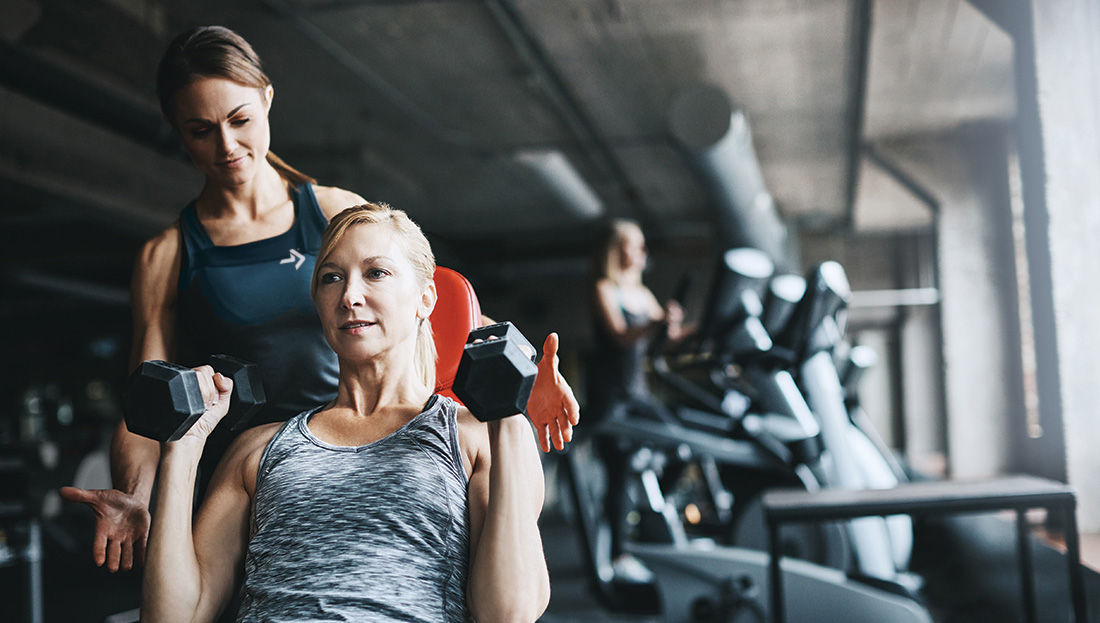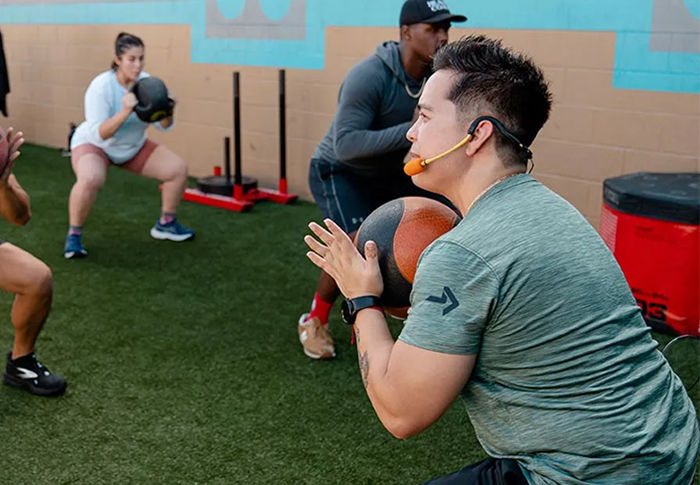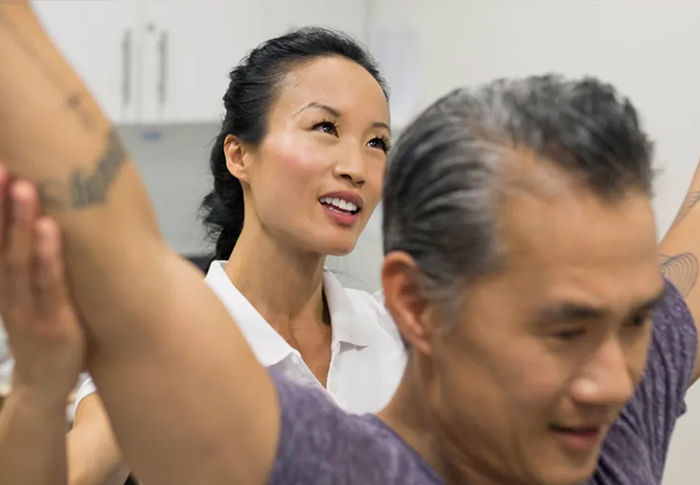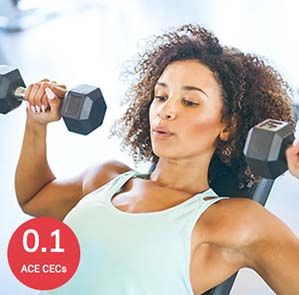
I was 51 years old when COVID hit, and, as it did for so many people, life felt like it abruptly came to a standstill. I became more sedentary with my work, which was now done at home on a computer as I transitioned away from training and teaching group fitness and yoga to more writing and editing.
According to Wendy Sweet, PhD, I was also at the average age for menopause. And while the reduction in physical activity and increase in sedentary behavior would explain some of the symptoms I experienced—high-intensity workouts not feeling good anymore and the deep-seated pain I had for days following those more intense workouts—menopause might have been a contributor, too.
Menopause is getting more attention these days but it has not always been this way, says Bruce Dorr, MD, senior medical advisor for Biote, chairman for the Littleton Adventist Hospital OB/GYN department, and a reviewer for the Colorado Medical Board. “Historically, research and treatment of menopause have been egregiously neglected, to the extent that in the U.S., 80% of medical residents reported feeling ‘barely comfortable’ discussing or treating menopause, and only 20% of OB/GYN residency programs provide menopause training—most of which is through elective courses,” says Dorr, quoting stats from a 2018 AARP article. “Every woman will enter menopause, with 51 years being the average age of onset in the U.S. How can we have ignored a public health issue that affects half of our population?”
“Women are done suffering in silence,” says Carolina Barsa, MS, MBA, co-founder and Chief Innovation and Brand Officer for FitBiomics. “They are using their voices, plus the power of social media, to bring this very important topic into mainstream conversations. With celebrity role models helping to destigmatize menopause and increasing public awareness campaigns, women are feeling more empowered and comfortable to have candid discussions about historically ‘taboo’ topics.”
The “Baby Boomers” have helped pave the way, too. “We have the ‘Boomer’ generation to thank for the collective voice they provided on the topic,” notes Allison Harris, PT, DPT, board-certified clinical specialist in cardiovascular and pulmonary physical therapy and associate professor of physical therapy at Harrisburg University. “Since Boomers represent such a large segment of the population, as they age, they have created a generational shift that has helped to spotlight the experiences of older women and helped advocate for the needs of women throughout and beyond menopause. We are seeing more high-quality research studies looking at the interventions for menopause, which translates into more discussion and expanded treatment options.”
The Potential Cost of Menopause
As a health and exercise professional, if you work with women, you’re likely to have clients who are perimenopausal or postmenopausal. Perimenopause includes the years leading up to menopause, which is defined as the complete cessation of a woman’s menstrual period. Postmenopause is the period after a woman has not had a menstrual period for 12 consecutive months.
During perimenopause, which typically starts in the early 40s, hormone levels—including estrogen, progesterone and testosterone—begin to drop. This affects women in many ways, says Sweet, including energy, exercise response, sleep, moods, bone density, cardiac health and weight—especially weight around the midsection. Hot flashes can develop, too, which may disrupt sleep, social events and work. There are also vaginal changes, including atrophy and dryness.
These changes can trigger a vicious cycle. For example, if hot flashes or night sweats disrupt sleep, fatigue ensues and energy levels decrease, which means exercise may go by the wayside. A lack of sleep and exercise also affect mood, weight, bone density and heart health, and when you’re exhausted, the brain signals its need for simple carbohydrates for quick energy. Altogether, this increases stress levels, which stimulates the release of cortisol. And cortisol has connections to inflammation—and inflammation is linked to just about every chronic disease, from heart disease, cancer, and diabetes to autoimmune diseases, arthritis and depression.
All these changes can have devastating effects on a woman’s life, says Dorr, who references a 2022 Biote ‘Women in the Workplace’ survey of working women ages 50 to 65 years, which revealed that 25% of respondents have never been told by their primary care provider or OB/GYN that they were in perimenopause or menopause—despite 92% of these women experiencing one or more menopause symptoms within the past 12 months.
“Furthermore, the data demonstrated the significant economic impact of menopause, with four out of every 10 respondents reporting that menopause symptoms had interfered with their work performance weekly. In addition, 17% of respondents confessed they had quit or considered quitting their job because of menopause symptoms. These are women in the height of their profession and experience who felt the stigma and impact of menopause was significant enough to cut short their career.”
As a health and exercise professional, you are in a unique position to help women who are in this inevitable stage of life. And given the poor response from many medical professionals, you might be their primary point of support.
How to Open Up the Conversation About Menopause
Whether you’re a health coach, personal trainer, medical exercise specialist or group fitness instructor, it’s important to establish rapport and trust, and have open communication about menopause with the women you’re working with since they may not feel comfortable initiating the conversation.
Including questions about women’s health and lifestyle in your initial and occasional follow-up health questionnaires is an easy way to open up the conversation with these clients. Ask if they know where they are in the menopause journey and if they’re working with their healthcare practitioner regarding any symptoms of menopause, such as hot flashes and vaginal dryness or atrophy. Researchers recommend also including questions about sleep quality and social support, as well.
Take the time to ask about changes in their weight or body shape. Menopause tends to result in a more “apple”-shaped body due to the lack of estrogen, which encourages fat deposition in the midsection. Blood lipids also tend to increase. These changes increase a woman’s risk of heart disease, especially when metabolic syndrome is present, per a 2023 study in the Journal of Clinical Medicine.
Don’t forget to ask questions about depression, as well, which is common during menopause. The Centers for Disease Control and Prevention report that antidepressant use is highest among women ages 60 and over at 24.3%, closely followed by women ages 40 to 59 at 20.1%.
Additionally, you might consider including the PHQ-9, a nine-question assessment used by healthcare professionals to assess depression levels in patients. However, it is imperative that you do not diagnose or attempt to treat clients based on their results. It is equally as imperative that you encourage—or require them—to see their healthcare practitioner if their score is anything other than a 0.
“Mental health is important in any stage of life,” says Dorr, “but when hormone loss affects sleep, mentation [i.e., mental activity or thought processes] and comfort, stress and anxiety naturally increase.”
Dorr explains that as stress and cortisol levels increase, the symptoms of anxiety or depression are exaggerated. “The cognitive and mental symptoms of menopause are difficult to isolate, because they accompany other conditions, and in many cases, even the patient doesn’t realize the root cause of her symptoms is hormone imbalance,” says Dorr. “Sleep disruptions, anxiety, changes in appetite, fatigue, trouble concentrating and mood disturbances are all also symptoms of depression—and it’s not a coincidence that women of perimenopausal, menopausal and postmenopausal ages are prescribed antidepressants more than any other group in the country. While antidepressants may mask one or more symptoms, this treatment is not addressing the hormonal imbalance at the root of the problem, which may be causing many additional symptoms as well.”
Exercise As Therapy for Menopause
Exercise can be an effective therapy for many symptoms of menopause—and there is plenty of evidence to support this. For example, research suggests that strength training can be beneficial for improving strength, bone density, and hormonal and metabolic levels in menopausal women.
Further, a 2022 systematic review and meta-analysis published in Osteoporosis International highlights the importance of various forms of exercise on bone mineral density (BMD) in postmenopausal women. Interestingly, this review also suggests that postmenopausal women experience greater improvements in BMD with supervised exercise compared to non-supervised.
It’s also important to recognize that, while aerobic exercise is important for cardiovascular health, high-intensity exercise may not be feasible for many women in perimenopause—and may worsen hot flashes. The good news is they can get plenty of benefits from moderate-intensity exercise, which may have the added benefit of reducing hot flashes, according to a 2022 review article in the journal Menopause.
Yoga and other mind-body interventions have been shown to improve overall menopause symptoms. Specifically, a 2024 systematic review and meta-analysis suggests that mind-body exercises—including tai chi, yoga, Pilates, qigong, baduanjin (a traditional Chinese exercise that combines breathing, movement, meditation and awareness), and mindfulness-based stress reduction—have positive effects on BMD, sleep quality, anxiety, depression and fatigue in perimenopausal and postmenopausal women.
Other reviews also suggest that physical activity has a positive influence on menopause symptoms, as well as quality of life, depression, anxiety, mental well-being, perceived stress, life satisfaction and self-esteem. A 2020 study, also published in the journal Menopause, demonstrated that women in all stages of menopause who had higher levels of physical activity scored higher on positive affectivity and life satisfaction, and lower on depressive symptoms.
Research, including a 2019 study, suggests that pelvic floor exercises may improve a common postmenopausal condition known as genitourinary syndrome of menopause (GSM). Symptoms include vaginal dryness, vulvar atrophy, frequent urge to urinate, incontinence and painful intercourse. Even if your client doesn’t have GSM, pelvic floor exercises are still important, yet often neglected.
AMP-activated protein kinase (AMPK) is an enzyme that regulates energy balance by activating energy-producing processes and inhibiting energy-consuming ones. It has been shown to play a role in energy balance and fat oxidation at the cellular level. As estrogen levels drop during perimenopause, AMPK activity decreases. In fact, there is evidence that menopausal women with obesity have a more difficult time reducing body fat compared to women with less body fat, in part, due to a reduction in AMPK and lean body tissue. This is important to note because it may take postmenopausal women longer to reduce body fat compared to younger women, suggest the authors of a 2023 review, who also stress the importance of consistent exercise during menopause to positively influence body composition.
A lesser-known benefit of exercise is that it positively influences the gut microbiome, per a 2023 systematic review in the journal Nutrients. “In addition to supporting digestion and nutrient absorption, the gut plays a role in regulating hormones,” says Barsa. “This includes optimizing the sleep-wake cycle via the gut-brain axis, as well as modulating estrogen, which could help reduce the severity of menopause symptoms.”
Actionable Strategies for Managing Menopause
Based on the research findings presented above, here’s a list of actionable recommendations you can use with clients who are experiencing perimenopause or menopause.
1. Strength Training
- Focus on Strength Development: Incorporate progressive resistance training two to three times per week to improve muscle strength, bone mineral density (BMD) and metabolic health. Exercises like squats, lunges and rows are effective.
- Supervised Sessions: Encourage supervised strength-training sessions, which research suggests yield better outcomes for BMD.
- Promote Consistency: Regular strength training helps address body composition changes and supports long-term hormonal health.
2. Aerobic Exercise
- Prioritize Moderate-intensity Exercise: Design moderate-intensity aerobic programs (e.g., brisk walking, cycling or swimming) to support cardiovascular health and reduce hot flashes.
- Limit High-intensity Exercise: Be mindful of high-intensity training, as it might worsen hot flashes for some women.
- Encourage Variety: Combine aerobic exercises with other forms of movement to keep clients engaged and support adherence.
3. Mind-Body Practices
- Incorporate Yoga and Tai Chi: Include yoga, tai chi or other mind-body activities to improve sleep quality, reduce anxiety and depression, and alleviate fatigue.
- Mindfulness and Meditation: Offer mindfulness-based stress-reduction techniques to help manage emotional well-being and promote relaxation.
- Flexibility and Balance: Use practices like Pilates and qigong to enhance balance, flexibility and overall quality of life.
4. Pelvic Floor Exercises
- Address GSM Symptoms: Include pelvic floor exercises like Kegel routines to alleviate symptoms of genitourinary syndrome of menopause (GSM).
- Encourage Prevention: Educate clients about the importance of maintaining pelvic floor health, even if they’re not experiencing GSM symptoms.
- Combine with Functional Movements: Integrate pelvic floor engagement into daily exercises, such as squats or bridges, to build functional strength.
5. Body Composition and Fat Loss
- Set Realistic Expectations: Help clients who are menopausal understand that they may experience slower fat reduction due to hormonal changes and decreased AMPK activity, but consistency is key.
- Support Lean Tissue Maintenance: Incorporate protein-rich nutrition guidance alongside resistance training to preserve lean body tissue.
- Promote Sustainable Fat Loss: Combine regular exercise with balanced dietary strategies for gradual and sustainable fat loss.
6. Gut Health and Hormone Regulation
- Encourage Regular Exercise: Highlight how consistent exercise can positively impact the gut microbiome and regulate hormones like estrogen.
- Educate on the Gut-Brain Axis: Share how improved gut health can influence mood, sleep and overall hormonal balance.
- Incorporate Diverse Movements: Use a variety of exercises to support overall gut health.
7. Psychological and Emotional Well-being
- Foster Positive Affectivity: Promote higher levels of physical activity to improve life satisfaction and reduce depressive symptoms.
- Encourage Community: Create opportunities for group classes or peer support to enhance social connection and emotional well-being.
- Monitor Mental Health: Include discussions about stress management and mental health as part of your client consultations.
These suggestions emphasize a holistic approach to menopause support, combining physical, mental and emotional strategies to empower clients and improve their quality of life.
As you can see, regular exercise can positively influence many symptoms of menopause. Be cautious, however, about applying blanket recommendations and workouts to this population as a whole. Just like other age groups, perimenopausal and postmenopausal women have individual needs and preferences. Some will be able to engage in higher-intensity exercise, while others simply can’t. Listen to what your clients say about how they feel and adjust their programs as needed to ensure they can achieve their personal health and fitness goals. By doing so, you can play a major role in improving women’s lives during what can be a very difficult time.
Expand Your Knowledge
Training Female Clients Through Different Life Stages
This two-hour course provides health and exercise professionals with essential knowledge about the natural hormone cycle and its impact on women’s biology and physiology. You will explore the hormonal lifecycle, from adolescence through pregnancy, postpartum, and into perimenopause, menopause, and post-menopause. Backed by science and real-life experiences, the course offers a continuum-based approach to fitness, focusing on how hormonal changes influence exercise programming. It also provides practical strategies for communicating about the menstrual cycle and creating tailored programs for each life stage, especially for midlife and beyond. By aligning exercise regimens with hormonal status, professionals can improve client results, retention, and overall value.
Strategies for Training Female Clients – Course Bundle
The Maximize Your Female Client Training Sessions course bundle equips health and exercise professionals with a holistic approach to optimizing the fitness and health outcomes of female clients by understanding their unique needs, life stages and goals. This comprehensive program, which includes Weightlifting for Women, Training Female Clients Through Different Life Stages, and Training Women for Optimal Health and Performance, emphasizes the importance of tailoring training techniques to align with the hormonal and physiological changes women experience throughout their lives. By mastering these strategies, you can better serve female clients, delivering tailored programs that maximize results, increase client retention and empower women to thrive at every stage of life.
Weightlifting for Women
This course empowers health and exercise professionals to break through the myths and stigmas surrounding women and strength training, emphasizing the vital role weightlifting plays in improving postural alignment, skeletal integrity and overall health. This video-based training dives into the barriers preventing women from engaging in weightlifting and the physiological advantages it provides. You will learn the best strength exercises women should regularly perform to enhance functionality, performance in life and sport, and long-term health outcomes. With a holistic approach that integrates physical, emotional and cognitive coaching, this course will equip you with the tools to educate and inspire your female clients, helping them embrace strength training as a necessity for their fitness and well-being.





 by
by 





